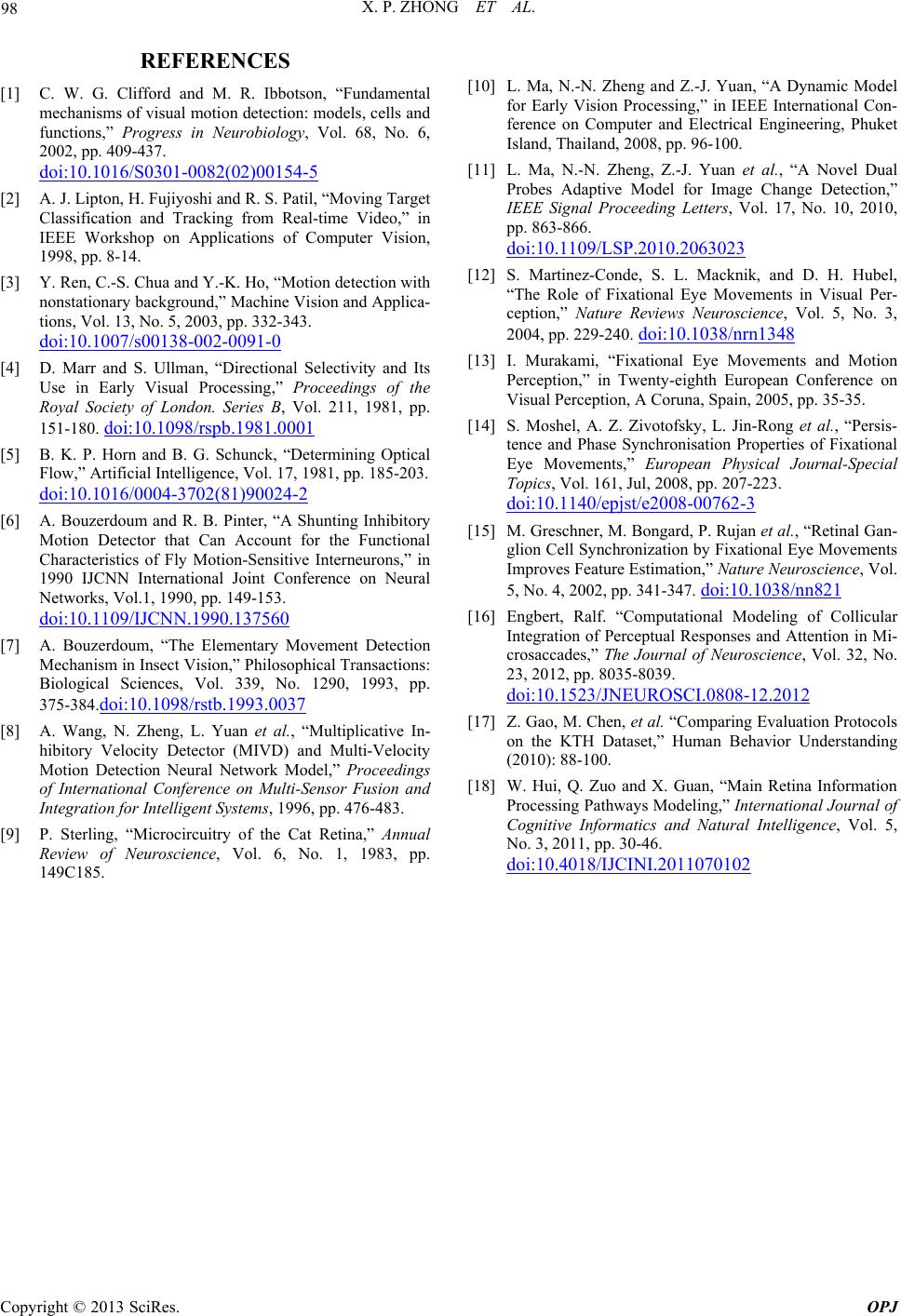
X. P. ZHONG ET AL.
Copyright © 2013 SciRes. OPJ
98
REFERENCES
[1] C. W. G. Clifford and M. R. Ibbotson, “Fundamental
mechanisms of visual motion detection: models, cells and
functions,” Progress in Neurobiology, Vol. 68, No. 6,
2002, pp. 409-437.
doi:10.1016/S0301-0082(02)00154-5
[2] A. J. Lipton, H. Fujiyoshi and R. S. Patil, “Moving Target
Classification and Tracking from Real-time Video,” in
IEEE Workshop on Applications of Computer Vision,
1998, pp. 8-14.
[3] Y. Ren, C.-S. Chua and Y.-K. Ho, “Motion detection with
nonstationary background,” Machine Vision and Applica-
tions, Vol. 13, No. 5, 2003, pp. 332-343.
doi:10.1007/s00138-002-0091-0
[4] D. Marr and S. Ullman, “Directional Selectivity and Its
Use in Early Visual Processing,” Proceedings of the
Royal Society of London. Series B, Vol. 211, 1981, pp.
151-180. doi:10.1098/rspb.1981.0001
[5] B. K. P. Horn and B. G. Schunck, “Determining Optical
Flow,” Artificial Intelligence, Vol. 17, 1981, pp. 185-203.
doi:10.1016/0004-3702(81)90024-2
[6] A. Bouzerdoum and R. B. Pinter, “A Shunting Inhibitory
Motion Detector that Can Account for the Functional
Characteristics of Fly Motion-Sensitive Interneurons,” in
1990 IJCNN International Joint Conference on Neural
Networks, Vol.1, 1990, pp. 149-153.
doi:10.1109/IJCNN.1990 .137560
[7] A. Bouzerdoum, “The Elementary Movement Detection
Mechanism in Insect Vision,” Philosophical Transactions:
Biological Sciences, Vol. 339, No. 1290, 1993, pp.
375-384.doi:10.1098/r stb.1993.0037
[8] A. Wang, N. Zheng, L. Yuan et al., “Multiplicative In-
hibitory Velocity Detector (MIVD) and Multi-Velocity
Motion Detection Neural Network Model,” Proceedings
of International Conference on Multi-Sensor Fusion and
Integration for Intelligent Systems, 1996, pp. 476-483.
[9] P. Sterling, “Microcircuitry of the Cat Retina,” Annual
Review of Neuroscience, Vol. 6, No. 1, 1983, pp.
149C185.
[10] L. Ma, N.-N. Zheng and Z.-J. Yuan, “A Dynamic Model
for Early Vision Processing,” in IEEE International Con-
ference on Computer and Electrical Engineering, Phuket
Island, Thailand, 2008, pp. 96-100.
[11] L. Ma, N.-N. Zheng, Z.-J. Yuan et al., “A Novel Dual
Probes Adaptive Model for Image Change Detection,”
IEEE Signal Proceeding Letters, Vol. 17, No. 10, 2010,
pp. 863-866.
doi:10.1109/LSP.2010.2063023
[12] S. Martinez-Conde, S. L. Macknik, and D. H. Hubel,
“The Role of Fixational Eye Movements in Visual Per-
ception,” Nature Reviews Neuroscience, Vol. 5, No. 3,
2004, pp. 229-240. doi:10.1038/nrn1348
[13] I. Murakami, “Fixational Eye Movements and Motion
Perception,” in Twenty-eighth European Conference on
Visual Perception, A Coruna, Spain, 2005, pp. 35-35.
[14] S. Moshel, A. Z. Zivotofsky, L. Jin-Rong et al., “Persis-
tence and Phase Synchronisation Properties of Fixational
Eye Movements,” European Physical Journal-Special
Topics, Vol. 161, Jul, 2008, pp. 207-223.
doi:10.1140/epjst/e2008-00762-3
[15] M. Greschner, M. Bongard, P. Rujan et al., “Retinal Gan-
glion Cell Synchronization by Fixational Eye Movements
Improves Feature Estimation,” Nature Neuro sci enc e, Vol.
5, No. 4, 2002, pp. 341-347. doi:10.1038/nn821
[16] Engbert, Ralf. “Computational Modeling of Collicular
Integration of Perceptual Responses and Attention in Mi-
crosaccades,” The Journal of Neuroscience, Vol. 32, No.
23, 2012, pp. 8035-8039.
doi:10.1523/JNEUROSCI.08 08-12.2012
[17] Z. Gao, M. Chen, et al. “Comparing Evaluation Protocols
on the KTH Dataset,” Human Behavior Understanding
(2010): 88-100.
[18] W. Hui, Q. Zuo and X. Guan, “Main Retina Information
Processing Pathways Modeling,” International Journal of
Cognitive Informatics and Natural Intelligence, Vol. 5,
No. 3, 2011, pp. 30-46.
doi:10.4018/IJCINI.20110701 02